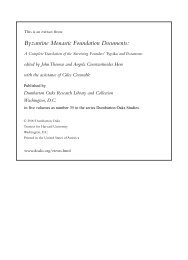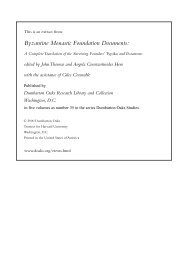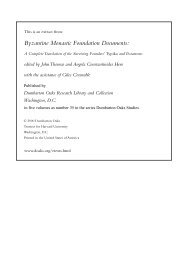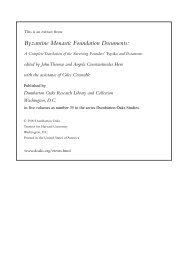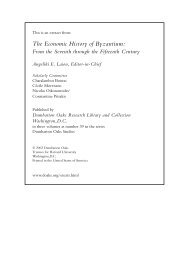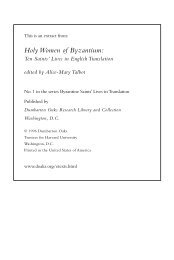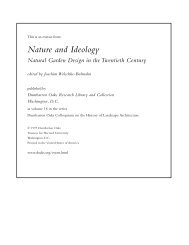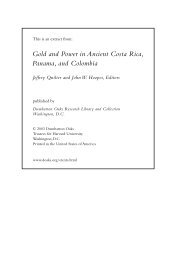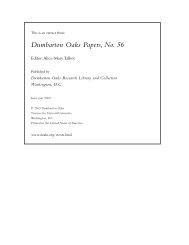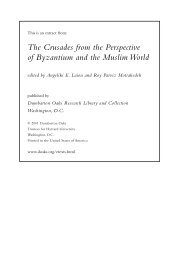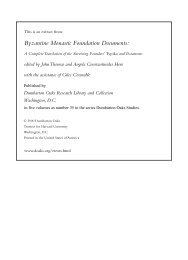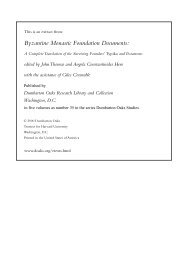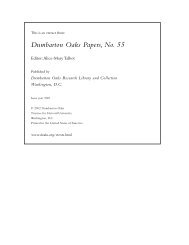The Zooarchaeological Record from Formative ... - Dumbarton Oaks
The Zooarchaeological Record from Formative ... - Dumbarton Oaks
The Zooarchaeological Record from Formative ... - Dumbarton Oaks
You also want an ePaper? Increase the reach of your titles
YUMPU automatically turns print PDFs into web optimized ePapers that Google loves.
<strong>The</strong> <strong>Zooarchaeological</strong> <strong>Record</strong> <strong>from</strong> <strong>Formative</strong> Ecuador<br />
we retrieve samples <strong>from</strong> any excavated site has an enormous influence both<br />
on the kinds of taxa present and their relative quantities (e.g., Stahl 1992).<br />
Some excavated collections contain no zooarchaeological data. Some were only<br />
casually recorded or partially analyzed. Some were lost, and more recently some<br />
reflect the heavy use of intensive recovery techniques. Depending upon the<br />
specific circumstances of recovery, analysis, and curation, assemblages vary in<br />
their representation of taxa, thus compromising intersite comparability.<br />
<strong>The</strong> well-explored relationship between sample size and assemblage diversity<br />
must also be taken into consideration. As a function of increased sample<br />
size, the number of different categories (richness) in any sample rapidly increases<br />
to a point where fewer new categories are added at a much slower rate. This<br />
tight correlation between richness and sample size can be demonstrated for<br />
Ecuadorian faunal assemblages <strong>from</strong> the western lowlands, as can the related<br />
statistic measuring the distribution or spread of abundances across recovered<br />
categories (evenness). In those few cases where sample size does not correlate<br />
with assemblage diversity, separate measures of richness and evenness are controlled<br />
by either excavation sampling and/or site assemblage formation (Stahl<br />
1992; n.d.d).<br />
In short, the interpretation of presence or absence and relative abundance<br />
data is usually not straightforward. Years ago, Grayson (1981; see also 1979:<br />
227–229; 1983: 100; 1984) detailed most of these problems and cogently argued<br />
that the use of relative abundance—in the form of frequencies or ratios—can<br />
be fraught with difficulty, as it makes too many assumptions about<br />
the structural relationship between the excavated sample and its parent population.<br />
Unless we can control for all the effects of assemblage formation history,<br />
and we normally cannot, then we should treat inferences <strong>from</strong> ratio scale data<br />
with healthy skepticism. Fortunately, nominal scale data, whereby taxa are parsimoniously<br />
treated as variables that can be either present or absent, make far<br />
fewer assumptions. Of course, reliable inferences asymmetrically emphasize<br />
presence over absence, as the presence of a taxonomic category in a collection<br />
is verifiable, whereas its absence is not. Along with archaeological context and<br />
analogical reasoning, we can use these qualitative data to build inferences about<br />
prehistoric subsistence and ecology. <strong>The</strong> reliability of these inferences can be<br />
corroborated through the repeated excavation of similar associations in contemporaneous<br />
archaeological deposits throughout a particular region. <strong>The</strong>ir<br />
validity can be corroborated through association with other fauna that demonstrate<br />
similar evidence for diet or shared ecology and then independently checked<br />
with separate lines of botanical and contextual evidence.<br />
181




